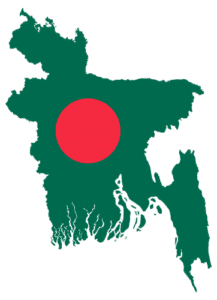Country Profile
Bangladesh

Bangladesh stands as one of Asia’s fastest-growing economies, propelled by a robust textile and garment industry. Fueled by a dynamic workforce and increasing foreign investment, the country is rapidly expanding its industrial and export capacities. Key exports to India include ready-made garments, jute, and food products, while imports such as cotton, steel, and machinery support its manufacturing base. Strengthening trade ties with India is unlocking new opportunities for investment, infrastructure growth, and regional economic integration.
Geographically, Bangladesh—often referred to as the “Land of Bengal”—is a low-lying deltaic nation cradled between the Ganges, Brahmaputra, and Meghna rivers, with its southern coastline opening into the Bay of Bengal. It shares borders with India on three sides and Myanmar to the southeast, with Nepal and Bhutan just beyond India’s narrow Siliguri Corridor. Spanning approximately 130,170 km² and with a population density of around 1,350 people per square kilometer, Bangladesh ranks among the world’s most densely populated large nations.
GDP Per Capita
Approximately $2,878 USD, reflecting steady growth aligned with rising national income
Learn MoreForecasted at approximately $482 Billion by the end of 2025—a reflection of sustained economic growth
Learn MoreThis represents approximately 2.13% of the total world population, making Bangladesh the 8th most populous country.
Learn MoreThe fertile land supports a large agricultural sector, while the garment industry utilizes urban areas, and renewable energy projects are developing previously underutilized land.
Learn More| Metric | Value |
|---|---|
| Total Import (India) | US $11.07 Billion |
| Total Export (India) | US $1.84 Billion |
| Total Import (Global) | US $77 Billion |
| Total Export (Global) | US $57 Billion |
| Public Debt (Domestic) | 15.8% of GDP (Jan 2025) |
| Unemployment Rate | 5.0% (2023–24), youth unemployment ~16% |
| Inflation Rate (CPI) | 5.5% as of June 2025 |
| Labor Force | 77.4 million (2024 WB estimate) |
| Inflation Rate (CPI) | 8.48% as of June 2025 |
| Investment to GDP Ratio | 29.4% (down from 30.7% in FY24) |
| GDP by Sector (approx.) | Agriculture: ~1.8%, Industry: ~4.3%, Services: ~4.5% growth |
| GDP Growth Rate | 3.9% as of June 2025 |
Exports reached $39.35 billion in FY 2024‑25 (up 8.8%), accounting for ~81 % of national merchandise exports—anchoring the economy despite global pressures newagebd.net.
The industry is moving up the value chain: vertical integration, smart factories (AI/automation), sustainable LEED-certified facilities (180+), and green practices are boosting competitiveness
Merchandise exports surged to $48.28 billion in FY 2024‑25—an 8.6 % increase year-over-year .
RMG shipments rose 10.6 % to $30.25 billion in July–March FY25 .
Non-RMG sectors—leather (+10 %), engineering (+10 %), footwear (+11 %), agro-products, pharma (+7.9 %) — show growing export momentum .
BIDA launched an FDI Heatmap for 19 priority sectors (textiles, pharma, IT, renewable energy, light engineering, leather, logistics, electronics) bida.gov.bd+1tbsnews.net+1.
Special Economic Zones are flourishing—e.g., Bangabandhu Sheikh Mujib Shilpa Nagar around Chittagong, with >150 units, $ billions in investment, and 775,000+ jobs planned en.wikipedia.org+1en.wikipedia.org+1.
Pharma is near self‐sufficiency domestically and exported $134 million in Jul‑Feb FY25 (+13%) en.wikipedia.org+1investbangladesh.co+1.
Electronics and home appliance manufacturing is booming (~$5 billion market expected by 2025), with strong domestic brand presence.
Annual FDI inflows hovered around ~$3 billion in recent years; low at ~0.3–0.5 % of GDP .
Authorities are actively courting investors via the heatmap strategy and eco-zone expansion, with 60+ international investors (US, SK, China, Japan, EU, Australia) touring Chittagong in April 2025.
Port & logistics: Maersk and DP World are exploring major Bay of Bengal investments to boost maritime capacity reddit.com.
The Bangabandhu Shilpa Nagar SEZ is underway with robust multi-modal port, rail, and power infrastructure, targeting corridor development by 2030 reddit.com+13en.wikipedia.org+13en.wikipedia.org+13.
Government‑World Bank deals launched in April 2025—$650 million for Chittagong Bay Terminal upgrades and $200 million for social resilience .
Sector volatility: a 37% U.S. tariff threat on cotton could disrupt RMG; Bangladesh is negotiating improved access and bonded warehouses for cotton imports ft.com.
A May–June 2025 NBR strike halted tax and customs operations, briefly disrupting trade at Chittagong port; operations have resumed but highlight institutional vulnerabilities en.wikipedia.org.